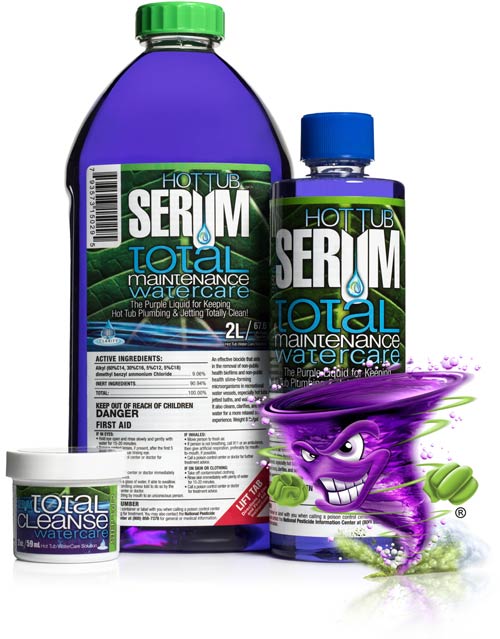One of the popular options in recent years for spas, particularly among higher-end hot tubs, is a Salt System. Though Serum Total Maintenance is compatible with all sanitation methods, it is particularly beneficial with Salt System Spas, so let’s take a look at this popular option.
The History of “Salt” as a Sanitizer
To start, salt is not actually the sanitizer, though the salt will make the water feel softer and increase your buoyancy, thereby increasing the therapeutic value of a Salt System spa. The salt concentration is also too low for you to taste, but you will know it’s there by the softer feel of the water.
The actual sanitizer is standard chlorine or bromine. The difference is that these are “split” from the salt molecule, either sodium chloride (NaCl) or sodium bromide (NaBr). Unlike other sanitizers, such as dichlor, trichlor, bromine tabs, etc., no other chemicals are part of the sanitizing process.
The Salt System concept goes back some 40 years to Australia where they first developed it to sanitize pools. About 30 years ago, the concept was brought to the US. Today Salt System pools are among the most popular in the US. One reason is that you cannot burn your eyes in a Salt System pool because the only chemical being used is salt and the salt concentration is actually lower than in your own tears. Finally, around 20 years ago, spa manufacturers started experimenting with the Salt System concept to sanitize hot tubs.
Who Offers a Salt System Option?
We began our discussion of this option in our SERUM & Salt System Spas section, noting that there are two versions of this option. Salt systems can be based on sodium chloride (NaCl), hence producing chlorine as the sanitizer, or sodium bromine (NaBr), producing bromine as the sanitizer.
The largest manufacture of NaCl Salt Systems is Watkins Wellness™, the manufacturer of both Hot Spring® Spas and Caldera® Spas. Watkins offers their Freshwater® Salt System in both their high-end and mid-line spas.
Two companies provide most of the NaBr Salt Systems. Gecko Alliance, a Canadian company, offers their in.clear system. Blu Water Technology offers their Blu Fusion Automatic Bromine Generator. Both of these companies are not spa companies. Rather, they provide their salt systems to spa manufacturers, hence they are found in hot tubs from more than one manufacturer.
How SERUM Improves Your Salt System Spa Experience
All spa sanitation systems have their weaknesses and Salt is no exception. It’s a great system, but it’s not “bullet-proof”. However, SERUM Total Maintenance solves all the issues Salt Systems can experience!
1. Salt Systems Produce Chlorine or Bromine Slowly
First, Salt Systems convert salt while your spa is in filtration mode. They have to in order to flow water through the electrode that converts the salt. They operate on very low voltage DC current and gradually convert this salt, operating anywhere from 12 – 24 hours a day. They are not designed to produce large quantities of chlorine or bromine quickly.
Salt Systems are essentially designed to maintain the proper level of sanitizer in your spa water. Hence, if you suddenly increase the sanitation load (bather load) on your spa by using it more than you usually do, you will deplete the available sanitizer, likely to 0 ppm. Until the sanitizer level returns to normal, usually in 12 – 72 hours, bacteria is growing in your spa water and biofilm is developing in your spa’s plumbing. As a back-up, secondary sanitizer, SERUM Total Maintenance continues to kill bacteria to prevent both problems. Your spa water remains crystal clear and safe for use.
2. Chlorine Salt Systems Have You Remove Calcium
Second, the Freshwater Salt System instructions have you remove most of the Calcium (Ca) in your spa water. The instructions want a Ca level of 50 ppm or lower. Note that tap water usually runs from around 100 – 400 ppm, though water in some parts of the country, particularly from wells, might exceed 500 ppm.
Lowering the Ca level reduces the likelihood of Ca scaling but is also makes keeping your pH in the proper range of 7.2 – 7.6 somewhat more difficult because Ca is, what is called, a pH buffer. It helps reduce swings in pH. SERUM Total Maintenance is a very effective pH buffer helping you maintain the proper pH level of your spa water.
3. Chlorine’s Ability to Kill Bacteria Drops Rapidly with High pH Levels
Third, as we discuss in our FAQ, “When is chlorine not effective in killing spa pathogens?”, the chlorine in your spa may not be ensuring all pathogens in your spa are killed. Both high pH and high cyanuric acid levels (found in dichlor) quickly reduce chlorine’s ability to kill bacteria and other pathogens in your spa
SERUM Total Maintenance solves this problem in two ways. One, Total Maintenance is the only EPA Registered spa product that works as a back-up, secondary sanitizer. It’s killing pathogens even when chlorine is not. Second, as noted above, Total Maintenance is also helping to keep your pH in the proper range to ensure the chlorine in your spa is operating at peak performance.
4. Bromine Salt System Electrodes Can Develop Calcium Scaling
Fourth, bromine salt systems generally do not instruct you to lower Ca levels to 50 ppm or lower. Despite potentially higher Ca levels in your area, Ca scaling is not an issue unless you allow your pH to rise above 8.0. Ca scaling occurs at pH levels above 8.0, and if Ca scaling occurs it will first be seen in the Salt System electrode.
As we noted above, SERUM Total Maintenance is a powerful pH buffer. Total Maintenance prevents Ca scaling in your spa and on your Salt-System electrode by keeping your spa water pH in the proper range of 7.2 – 7.6.
Thanks for reading,
Turbo Tony






